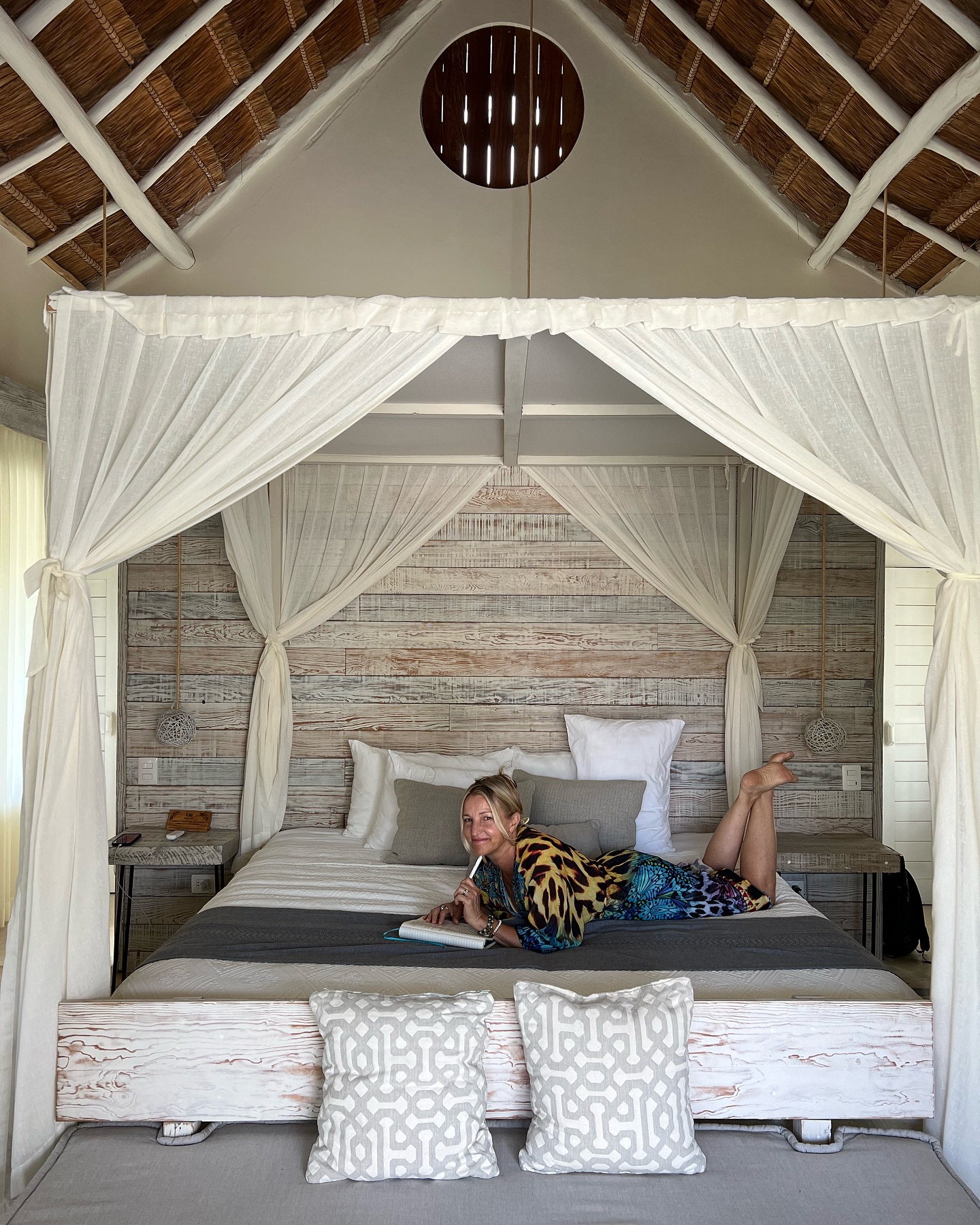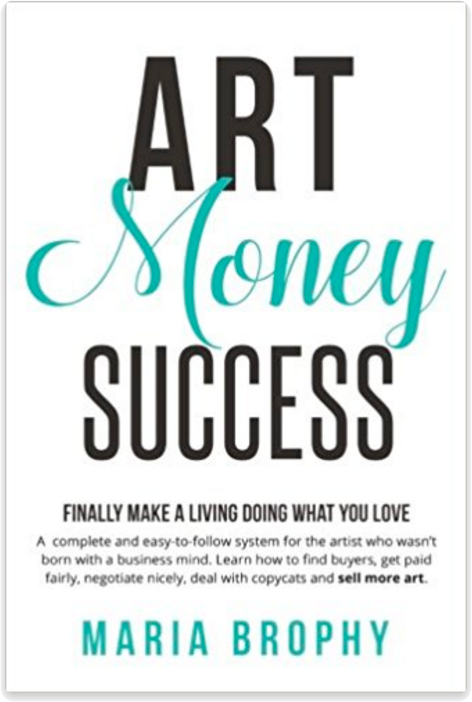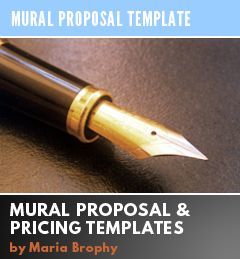
Even though I’ve been managing the art career of my husband Drew for over a decade, it wasn’t until recently that we established a solid pricing structure for Drew’s original artworks.
A couple of years ago when a collector would ask “how is Drew’s artwork priced?” I didn’t have a good answer – there was no real structure to our pricing. Now, there is, thanks to Lori Woodward’s wisdom. Now when someone asks, I can confidently say “we charge $1.50 per square inch plus frame costs. Commissions start at $2.50 per square inch.” When you have a structure that makes sense in a collector’s mind, they are more confident in buying your art.
One of the hardest decisions that artists have to make is how to price their works – pricing depends on so many factors: the popularity of the art, the medium used, the complexity and what the buyer is willing to pay. But there are some guidelines that you can follow.
How to Price your Artwork:
1 – Research galleries: Go out and see what’s being charged by artists that are at your level of work. Use that information as a guideline.
2 – Structure your prices: Once you have a structure that makes sense to anyone, pricing your work comes easy.
There are many ways to structure pricing. Some artists do it by size (i.e. a 16″ x 24″ is priced at $1800.00) and/or by medium (Oil paintings priced higher than acrylic).
The method that works for us is to charge by the square inch and then add the cost of the frame. This method is explained in the article below, written by Lori Woodward. Her wisdom helped me tremendously with pricing. And I hope that it helps you, too. I highly recommend it! (I also recommend visiting FineArtViews blog for other articles on pricing art. Click here.)
REPRINTED COURTESY OF FineArtViews
Today’s Post is by Lori Woodward, Regular contributing writer for FineArtViews. She is also a contributing editor for American Artist’s Watercolor and Workshop magazines and she writes “The Artist’s Life” blog on American Artists’ Forum. Lori is a member of The Putney Painters, an invitational group that paints under the direction of Richard Schmid and Nancy Guzik. Find out how you can be a guest author.
Learning From My Professional Friends
Years ago, when I first started selling my work at outdoor shows, I looked to my friend,Monique Sakellarios for advice on pricing my artwork. After all, Monique had been selling her work successfully for several years at both outdoor shows and galleries; she was, and is, making the kind of income many of us only dream of. At the time, Monique priced her work by size. When she had a good selling year, she boosted her retail prices by 10%. If the economy was slow, she opted to maintain the same price scale she had used the previous year.
I asked Monique if she priced some of her best works slightly higher, and she said absolutely not — because she had observed that her clients would sometimes fall in love with a work she didn’t like very much, and if she priced some lower than others of the same size, collectors wondered if something was wrong with the less expensive painting — it would sit there unsold.
Knowing that Monique is an astute business woman, I followed her pricing procedure when it came to my own work. Of course, I did not price my works as high as hers – she was a well known artist in the New England region; I was not known at all.
More Than One Way That Works
If there were only one standard way to price artwork – there would be very little confusion around the issue of setting prices. Galleries generally have the artist set the prices, but whether you’re working with a gallery or selling on your own, pricing by the square inch is sometimes the easiest way to get started while showing consistency. When you’re first starting out, it’s a good idea to make your work as affordable as you can while being able to cover your costs and make a small profit. Don’t charge so little that you don’t break even.
OK, without further ado, here is how many artists price their work using a square inch method. Generally, they increase the dollar amount for smaller paintings and decrease it for very large paintings. So, let’s begin with pricing a medium sized painting – we’ll use a 16×20 work as an example.
First, multiply the painting’s width by its length to arrive at the total size, in square inches. Then multiply that number by a set dollar amount. I currently use $6 per square inch for oil on linen paintings. A 16”-x-20” painting: = 320 square inches.
I price my oil paintings at $6 per square inch. 320 x 6 = $1,920.00 and I round this down to $1,900. My frame, canvas and materials cost me $150.00 (I buy framing wholesale). I double this cost so that I’ll get it all back when the painting sells at the gallery. Otherwise, I’m subsidizing the collector by giving him or her the frame for free. $150 x 2 = $300
Then I put it all together: $1,900 + $300 = $2,200 (the retail price). When the painting sells from a gallery, my cut after the 50 percent commission is paid comes to $950 for the painting and $150 for the framing and materials, for a total of $1,100.
For much larger pieces, I’ll bring the price per square inch down a notch … maybe a dollar or two lower so that I don’t price my work beyond what my reputation can sustain. Alternately, for smaller works, I’ll increase the dollar per square inch because small works take almost as much effort as larger works, and I need to be compensated for my expertise, even when the work is miniature.
This is not the only way to price artwork, but it’s one that keeps my prices consistent and keeps me sane. By the way, my prices were much lower 10 years ago when my artwork was relatively unknown to collectors. When I began working with galleries, I had to increase by 20% or so in order for my prices to be in line with the other works in the gallery. When I have a great selling year, I raise my prices by 10 percent. When the economy is poor or my sales are slow, I don’t raise prices at all.
———————————————-
This article appears courtesy of FineArtViews by Canvoo,
a free email newsletter about art, marketing, inspiration and fine living for artists,
collectors and galleries (and anyone else who loves art).
This article originally appeared at:
http://fineartviews.com/blog/17649/art-pricing-strategies-3
For a complimentary subscription, visit: http://www.fineartviews.com
———————————————–
.















99 Responses
this is helpful, some of my pieces take over 30 hours, plus cost of canvas and pens, i’m stoked to sell them for a hundred bucks, so after time and materials i make about 2-3$ per hour
Well, that wouldn’t work for pricing out the entire back wall of a house that I did a mural on.
However for smaller works, it seems a good way. I like charging by time myself and what I think it will take. I’ve become pretty good at judging. But it’s taking me to do a lot to learn and, by timing myself.
After all, time is money.
I agree, Dennis. Time is money! It’s so hard sometimes to determine how much time a project will take. Often, just when we think we know, we are thrown a curve-ball.
I put paintings in a different category than the murals.
For murals, we have a different price structure. It’s $35.00 per square foot, starting with a minimum of $5,600.00. We give price breaks at 290 SF , 500 SF and 900 SF. Is that in line with what you’re charging?
Many artists charge $40 – $50 per square foot for murals, but our pricing seems to work for us. Drew’s very efficient, so he’s able to charge a little less.
As per this article on pricing ones artworks what would be the way to figure pricing for an art piec that has been sculpted and painted?.
Hope I get a reply to my query.
Kenneth C Young
I’d say that’s about right.
Though with going by square foot, it still depends on how much time is in that foot. Ya know?
But I think it would square out to be right.
Hi María, I forgot to comment on this when I first read it. But… THANK YOU! Excellent article. Definitely learned a lot from it.
I do mostly commercial work, but would love to do more artistic work in the near future. -D
I have a question about this – and i’m going to also ask Lori – just how did she come up with $6 a square inch? What things did she factor in to get to that amount?.
Thanks for your blog Maria, great advice and a really wonderful writing style!
What should I charge for a watercolor painting? How much per square inch?
Finally! An article about pricing that makes sense! Thank you for this. I am just starting out and i have not been able to find a straight answer on pricing out there. I will be doing this for sure! thanks again! (found your blog thru Meylah and I have subscribed to your RSS feed)
To answer the question about how to come up with the $ per square inch ($1.50 per square inch is what we charge for Drew’s paintings – more for commissions. Lori Woodward charges $6.00 per s.i.)
Do some research and see what other, established artists are charging for similar style, medium, etc. to yours. See what’s being charged both in galleries and online. This should help you determine a starting point.
You have to start somewhere, so just get started and make adjustments to your pricing as time goes on.
Thanks Maria, but I still don’t think that this way is the right way for me. My costs of doing business could be so much more than other artists – or they could be selling to a different financial demographic than me.
That is the reason for my question in the first place.
Fiona, the exact pricing we use may not work for everyone. If your expenses and time is more than the pricing we use, than increase your per square inch price accordingly. I think the most important thing is to have a system for pricing that makes sense to both you and your clients.
Aloha Maria,
Love your blog!! and thank you for offering all this wonderful advice, especially on pricing because it can really make my head spin!!! I was wondering if you have any input on how to make a good website? I looked over all your posts, did I miss it? or maybe a topic for a future post? Just a thought…
THANK YOU! I swear every time I come here for a read I find an answer ive been looking for for years! This pricing method seems like a perfect formula for me and I’m going to start using it now.
Nice site, Maria, and an interesting post! I have not actually been using the dollars per square inch model suggested here, but it does make sense. I’ve just applied the formula to several of my paintings at various sizes, based on actual sales (just to make sure that the numbers are real) and I’m surprised to see that there is a definite consistency and the principle works.
If I was actually going to use such a structured and exact approach, just as the author says, I agree that the larger paintings probably require a gradual reduction in the sq. in. price as the size increases – based on my recent actual pricing. So for me a 24″ x 36″ (0.6m x 0.9m) might be around US$ to $7 per sq. in., but a 60″ x 96″ (1.5m x 2.44m) (yes, that is quite big) would be more like $5.50 to $6 per sq. in.
Somewhere through the ‘middle’ sizes, the sq. inch price needs to step down a bit, maybe on a sliding scale, or a couple of increments.
If you don’t have such a wide range of sizes it would be easier to have just one fixed rate.
How does an artist establish those prices? Well it takes time and sales! When I first got my work into a gallery it was hung between well-known artist’s work but mine was a fraction of their prices for equal size. Some people were actually put off because of the apparent low value, but of course others just thought it was good-buying. Regardless, I had to “serve my time” according to the gallery owner, and who was I to argue? I was supposedly extremely privileged just to have a couple of paintings in a gallery!
As paintings began to sell as quickly as I could produce them the prices simply went up to reflect their popularity and allow me to slow down a bit.
I like the $1.50 – $2.50 per sq in price guide. I don’t often do a “fine art” piece, which does help keep my expenses down. I don’t have to keep inventory of canvas, sheet metal and other blank goods to paint on. My customers usually bring me things they want personalized.
But when I do (whether it be a metal sign blank, goalie mask, motorcycle helmet, motorcycle, etc) I charge $75.00 per hour. Then I try to “guesstimate” how long that particular job will take me to do.
I paint a goalie mask every few months. Some I can get top dollar for. Others think because I paint t-shirts, that airbrush art is cheap. The other day a kid came in with a real rough sketch of a zombie face he wanted on his goalie mask. I quoted $200.00. I thought he was going to swallow his tongue. I explained that there was a whole prep process, I use automotive paint which is not cheap and it’s cleared with a high grade automotive clear. His mom said they would get back to me.
I did another mask for $350 which took me a little longer than expected. I told the customer if anyone asks, he paid $500.00. He said No problem. He could see it was worth that much. He loved the finished piece.
So some jobs are hit and miss. Other times I quote jobs because times are slow and I need the work. Not that I’m out of pocket with materials. Most stuff is around the shop. It;s just the amount of time I spend on a job. You can’t get that time back and it sets you back if you have other jobs on the bench waiting to be painted.
The pricing structure that I use [spread sheets] one for plain stretched canvas and another for gallery wrapped stretched canvases involves a standard cost per square centimetre and a cost per cm of my gallery standard frames…Think about it all paintings have the same costs all paintings must make a contribution to your bottom line. That thing called profit? Why else would you paint day after day? That establishes a cost of a framed painting, then its rounded up to the nearest whole £…now add the shipping cost…and transfer the data to your e-commerce [online shop page]…its easy. You cannot agonise over the trivia: that this artwork is more detailed, this artwork used more expensive pigments, that this one took more time [unless a very large canvas err? why?].
I really can’t agree with your last sentence Meltemi. I’ll tell you why,,,
One of my 11 x 14 paintings took me over a year to complete because of the techniques, subject complexity, care needed to handle the colors and so on. So it’s priced up there with the larger paintings which I can finish in a month or so.
In short, there are exceptions to every rule. 😀
I had never thought of doing this by a per square inch bases, but as I go through the size and price of my wall sculpture it comes out about the same per square inch, a little more for the small ones and a little less for the larger ones. Before I ran the numbers I thought I was charging more for the big ones, but it turns out not. This will make pricing my work from here on a whole lot easier, thank you. Before I was calculating material costs, including hours spent, plus profit margin. I included hours spent in the materials since that was what I pay myself for the work, and what you get payed is what is used to pay the house hold bills.
now if I can just figure a way of applying this to full sculpture which I have been under charging for (paying myself less than minimum wage for the hours spent) only case is the market doesn’t seem to support one of a kind dragons for 5000 or more… or at least I haven’t found where I could sell them for that, well, not yet anyway. Let’s face it, when a full dragon sculpture uses 600-800 in raw materials and it takes 400 hours, 1000 hours if done with scales. It should cost a lot. Now that is where the difficulty in establishing a price per square, or cubic inch becomes difficult. Do I let my clients know they have different choices for different skin textures with different prices, or do I just price it for the most difficult one?
Its all very hard for me to base , my Arts Value(price) off the size and my cost and yes even MY TIME….
My emotional attraction ( connection) to my work,and how I feel about my design,and originality, represent a Much larger Value to me .
My process ..its diffrent each and every time.
But the consept is just as Precious?
What do you think…. no or yes or is how I feel ,is this a GIVEN to every one? and I am not understanding.
peace
Linda, I think that many artists feel the same way that you do – their work is a piece of them and the value is difficult to place.
For artists who rely on selling their artwork to earn a living, they have to price their work in a way that validates the value of the art, and at the same time ensures that it sells.
Linda I think you are right re. the precious-ness – it is your own work, from your own head, heart and hand. In an ideal world it should be valued at whatever YOU think it is worth.
However if you do want to sell your work there is a fuzzy line between the value you place on it and what other people might pay. The art becomes a trade-able commodity when it is put on the market and unless someone recognizes some extra value, its worth is established by non-artistic things like what else is available of a similar medium, quality, size and your prior sales history.
An artist’s own emotional connection to the art has little relevance at all (usually) to a buyer. The critical thing is purely the BUYER’s emotional connection, and whether it is strong enough to pay the price you are asking.
Once you’re established with a sales history, as soon as you put a blank canvas or paper on your easel it already has a projected finished price, based on previous sales of similar work. Then it is up to you to produce art that justifies that price to maintain your reputation.
Of course, some artists choose to remain “pure” and not “commercial” and that way they can value their artwork in any way they like.
I just graduated with my BFA and I just created my web site. I didn’t post any prices, because I wasn’t sure what I should charge. Would $1.00 per square inch be a good starting point? $0.75? $1.50? I want to think beyond just my area, because I plan on doing direct selling and we have the world wide web. I plan on opening an etsy store and maybe selling some of my work on ebay. What do you all think? Is $1.00 per square inch too cheap to start with?
Li, just as I said in the article above, do a little research. See what other successful artists are selling their work for, those that use a similar style and medium as you. Then use that as a general guide. If you’re just starting out, go lower and see what the market will bear. I wish you the best!
I have asked numerous artists how they price their work, and I never get a straight answer, so thank you for passing on this method of pricing. While I have sold photographs in the past, people are just beginning to show interest in my paintings, and I had no idea how to price them. This article has been very helpful.
I created an excel spreadsheet that can help with pricing. Check it out. it may be helpful. all you need to do is input your time and materials cost, and know what your gallery commission is and it will automatically figure a retail price for you. it is new so let me know if you find any bugs. thanks for sharing your helpful information. cheers.
http://www.damicogallery.com/how-to-figure-a-price-for-your-art-work/
Painting is my hobby. I have painted so many paintings to gift my friends. I didnt knew I can sell those. Where and how can I sell my paintings? I can paint what i see on photographs.
Hai I am an artist from India. My main works are oil paintings in canvas.I would like to sale my works. It costs $150 to $ 400 and the size will be 12″ x 7″” to 36″ x 24″ and more frame charge extra
please see my paintings in facebook…. aji paul perumba puthenveetil
Maria,
Thank you so much for this info. I appreciate everyone’s comments. This will help so much, and makes great sense.
Thanks again!!
Annette
To whom it may concern,
I am writing to introduce my self Roya Pourali as an unknown painter who was born in Iran 1984. I had studied in Architect engineering as academic studing, but, I`ve been painting more than 23 years old.
Moreover, I`ve been teaching drawing and painting professionally for several years.
As a matter of fact, I am writing to ask your help for showing my artworks, because for religous and cultural limitation, having public show for my painting are forbbiden in Iran.
Furthermore, political situation is not suitable for travelling abroad for Iranian people easilly, although, the only atmospher for demonstrating my painting are out of my country boundry.
With all explanation, I demand you to guid me for a sollution in order to find a way to show my artworks inpresentally.
Finally, I would be appreciated, if you can suggest me solloutions in order to solve my problems, and I can show my artworks free out of any political and religious limitation.
Hope to hear of you soon.
Best Regards,
Roya Pourali
Email:pourali.roya@yahoo.com
Tel:0098 912 339 5330
Painting is not a “get rich quick” scheme. I have suffered for many years, hoping to become a painter. Most of my time I’m sitting at a crappy job (like now) counting the hours until I can pick up my paint brush. By the time I do get a chance to paint the lifeblood is sucked out of me and I have to work while fatigued. Many great artists in museums all shared one common trait, this being that they had time to work on a regular basis. Many people don’t realize how much artists sacrifice in order to pursue their dream. These times require drastic measures to pursue such a dream.
It’s also important to protect your investment!! Having your artwork authenticated by professionals is an incredibly important step if you want to be successful in the art market. If you need any help on this please visit monetexperts.com. Have a great day!
Thanks for the article. My 11th grade daughter has painted a few pieces for people and we were not sure how to price her art. She has taken art though-out High School and is thinking about majoring in art in college. What rate would you recommend for a very beginner artist using the square inch method using acrylic paint? And should the price of the canvases be an additional price or included in the square inch price. Thanks
Hi Maria,am an artist in Uganda,africa.i do art paintings such as abstracts and other.i also do crafts.the help i need from u is to help me expand my talent and market to the western countries or connect me to any one who can help me because most africans are ignorant about art and the fact is i dropped out of school after college due 2 the luv of art and crafts that i had.thanx maria,pliz reply via my email(kawuki88@gmail.com)
Thank you all for bits of advice.I am new to the art world and pricing has been a night mare.Still abit concern as I think could it really sell for that price.I think now that I have under sold at an Art Fair..Thanks all…
so good
Finally a great formula for pricing my work in a reasonable way! I have bookmarked this site for its solid advice. The other articles are great too, but the pricing dilemma is a perennial problem for artists. Thanks so much!!
Im about to have a special showing of works that have been published in books and magazines over the last 20 yrs. My question is, do these paintings have added value because of publication and recognition.
Nice article you got here, at least I got a few ideas for pricing. However even with that said, the prices with the method you mentioned still seems like a bit much for what I’m doing. I’m going to be doing a 8-10 or 12-14 watercolor painting for my mother’s friend based on her two daughters. Small project but I want to find a reasonable price for the both of us. If anyone has any ideas please share. 🙂
pleae expline the painting rate in diteals….
I have been painting with watercolors as a hobby for several years now. I recently posted my paintings on Facebook and someone offered to buy one. It has never occurred to me to sell my work. My question is do you make copies and sell the originals or the other way around. This is all new to me.
Either way really. I would always reccomend trying both. But you need to hgave your works digitized. I reccomend scanning but some find photography does fine. Once the works are scanned there is no reason not to sit on those files until you are ready to sell a print. But at least while you have the priginal you have the opportunity to have a digital version ready for when you do decide to sell a print. As always you want your original price to be well above your print price. This is my business and i deal with it on a daily basis. So, if you have any questions please feel free to email me. I will gladly help any way I can: email@damicogallery.com
Oh my let me correct some errors (sorry): *have (not hgave), *recommend, original (not priginal).
Thank you that is helpful.
This is great info! Thank you for sharing! =)
Very helpful information. Thank you!
hello my name is tenzing m also buddhist painting business may i join with ur business?
2 questions.
1. About Lori Woodwards article. In her example she pays $150 for material and doubles that price to “get it all back” and give the frame for free. The painting cost $1900 (not including material and frame). Doesn’t she get the price of frame and material back by charging over 12 times the cost? How is she giving the frame for free?
2. Maria, How much does the gallery charge for commissions for Drews art? Would you consider that an average price and how much should a beginner expect to pay a gallery?
Hi Russ, to answer your 2nd question (I’ll let Lori answer the first):
Most galleries keep 50%. Some will agree to less, some will demand more. But 50% of the sale price is standard for a galleries share of your artwork sale.
We currently don’t work with any galleries; Drew’s art has a huge number of collectors and we have found that selling directly to the collectors is a better way for us to work – that way we keep 100% of the sale, and we can better develop a direct relationship with the collector.
However, sometimes we will agree to do a show with a gallery; and when we do, we negotiate that their 50% is determined AFTER we deduct the cost of the canvas/surfboard. This is because some of Drew’s paintings are on very expensive materials. For Example: a surfboard painting on a custom-made surfboard. Often the surfboard itself cost us $800 just to have it made. So we will have a written agreement that states that the 50/50 split is determined after we deduct the $800 from the total.
Just remember, everything is negotiable and most gallery owners will agree to a fair deal.
I was commissioned to paint Hawaiian Dancers for this Hotel lobby . 4ft x 6ft or bigger! would it be gross to buy the canvas already seized or stretched ? Is it worth more if I were to do my own ? How does someone know if I bought the canvas already seized? please any advice i appreciate , i’m nervous. and when I bought linen I made them go through the role to almost the end to find a piece that did not have little bumps or thread bumps on it.
Kev, thanks for the question. If you are confident you can do a professional job stretching the canvas yourself, then do it. But, if you think paying a professional to do it for you is better, then do that. You want to make a decision that will create the best result for your client.
I don’t understand your question “how does someone know if I bought the canvas already sized” – please clarify what you mean by that.
I am trying to sell my black art picture of a grandmother and granddaughter
Why can’t I sell my painting for what every I think they are worth???
Thank you this has been great info
Thank you so much have been selling my art for over 3 years now but never could figure out how to price and it got to where people were buying my work, just to sell for double what I sold it for. This method will help me so much!
Very helpful discussion and article. I price my paintings, framed, @ $10.00 per si regardless of size, detail, subject, or materials. It keeps my expectations consistent and lets customers know what to expect. My prints are $5.00 per si plus the cost of frame, mat, and glass.
This is a good way …i always undercharge my clients because i dont kno how to price my pieces ..thanks
Thanks for the advice..
my name is brima wolobah , I am a painter base in Monrovia (the capital of Liberia… On the coast of west Africa) I like the idea of prizing per square inches. I just recently started working with specific size,( 24″ / 36″ ) . Some works are more details then other is it fair to charge every thing the same..
my thanks to you from west Africa..